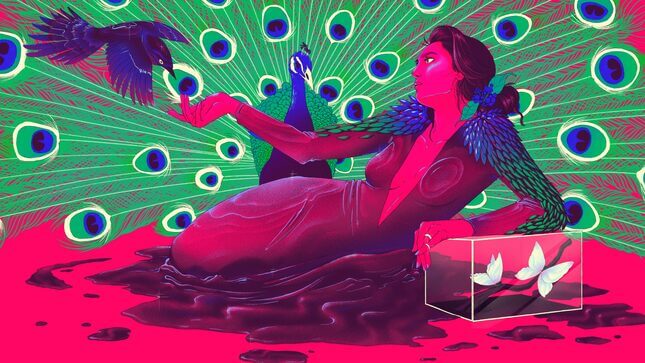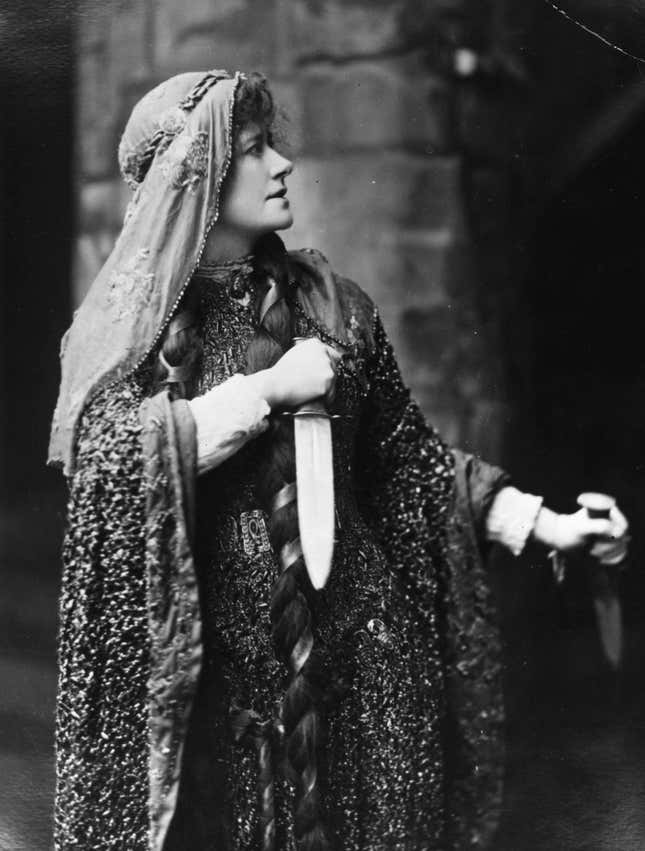From Victorians to Ravers: The Lustrous Magic of Iridescence in Fashion
In Depth
Illustration: Chelsea Beck
Ellen Terry wanted to look like a snake. She wanted her body to glimmer on stage, hard and soft at once, as though she were wearing the finest chainmail, the lightest armor. She was going to play Lady Macbeth, and Terry could be fussy about what she wore onstage. Not because she was vain, but because she understood both Shakespeare and the needs of her body; she knew instinctively, for instance, that Ophelia had to wear pink at the start of the show, and pale gold for the nunnery scene. She also knew she needed freedom of movement if she were to act properly; she had to be comfortable to embody her characters, to convince the audience. So she requested an iridescent dress, green and blue, fine and light, supple and strange.
Alice Comyns Carr, Terry’s costumer, didn’t disappoint. For Terry’s 1888 turn in The Scottish Play, she designed an emerald green gown with long, trailing bell-shaped sleeves, a high neckline, and over 1,000 beetle wings sewn onto the soft woven fabric. Dressmaker Ada Nettleship was responsible for bringing Terry and Carr’s joint vision to life (though it’s possible Nettleship was responsible for the beetle wing idea, since she had worked with this particular material before). When the show opened at Lyceum Theatre on December 31, painter John Singer Sargent was so struck by this version of the actress that he reached out and invited her to sit for a portrait in full costume. She arrived at his studio dressed the part, and Oscar Wilde (who was apparently on hand to comment) remarked, “The street that on a wet and dreary morning has vouchsafed the vision of Lady Macbeth in full regalia magnificently seated in a four-wheeler can never again be as other streets: it must always be full of wonderful possibilities.”

The dress now belongs to the National Trust and is housed at Smallhythe Place in Kent. You can see pictures of it online, but they’re disappointing. They don’t look as good as Sargent’s painting, which captures the glamor and romance of her body, that fabric, the thousand tiny wings. It dances like the northern lights. And like the aurora, the gown just doesn’t photograph very well. Like all iridescent things, it looks best when you can see how light plays over the surface of the cloth. When you freeze it, some of the wonder is lost. Possibilities are narrowed to a single point of view, a single focus. The colors become dull and lifeless, a drab olive green rather than a beguiling and impossible mixture of blue, green, red, orange, white.
This is, I think, what makes iridescent things so much more beguiling than objects that are simply shiny. Most shiny things (including metals like gold or silver) give off a gleam that can be named with one color word. But iridescent things reflect the whole range of colors; they give you a prismatic effect, a rainbow. A puddle is shiny. A bubble is iridescent. A silver ring is shiny. An opal is iridescent. They have luster. They have magic.

Kids know this. Kids love iridescence. But many adults have become inured to its charms, partially because we most often encounter iridescence in the context of oil and its material offspring. Today, you can buy an iridescent bikini online for $5. You can paint your face with iridescent make-up, turning your eyelids into a pair of shimmering beetle wings, your lips into oil slicks, your cheeks into fish scales. Iridescence has become somewhat commonplace, so it’s easy to forget that we haven’t always been able to make sparkly things, to buy them so cheaply. Before we had a firm grip on the many uses of fossil fuels, we had to rely on natural sources to sate our hunger for iridescence. We used to have to dig rocks from the ground or bother beetles for their cast-off wings.
There is evidence that people have been using beetle wings as decoration for hundreds of years. The oldest examples come from Japan and India, where “jewel beetles” are more common. The best beetles for the job belong to the Buprestidae family. There are over 15,500 species in the family, so there’s a good amount of variance, but in general these are wood-eating beetles with oblong bodies and hard outer shells. Some of them are large and intensely colored, with wings ranging in color from tangerine to emerald to blackberry. Like peacock feathers, their iridescence is caused by structural coloration, meaning that it’s a function of texture rather than pigment. You know how sometimes, when you look at a piece of roast beef under the kitchen lights, you’ll see a strange glaze on the surface? That’s the same thing—the fibers of the cow muscle are arranged in such a way that light enters through a thin film and bounces back at an angle. Little rainbows, everywhere.
Beetles aren’t the only creatures that have evolved with prismatic camouflage, but they are among the more plentiful and hardy. Certain species of butterflies, birds, and cephalopods all have structural coloration, but it would be quite hard to sew an octopus to a gown, and birds are higher up on the food chain than bugs, which means there are fewer of them to capture and strip. Plus, beetles shed their wings. You don’t necessarily have to kill them to get their goods. They leave it iridescent shells lying around, molting them like a deer sheds its antlers.
As far as I can tell, beetle wing art originated in India, Thailand, or China (or perhaps it sprung up independently, multiple discovery-style, in all three places). As far as natural materials go, beetle wings appear to be fairly easy to work with. You can steam them to make them more pliable, and drill holes in them one by one, or you can just pierce them with a needle and get on with it. Over the centuries, beetle wings have been used to add sparkle to dresses and hats, religious statues and shrouds. They were very popular in Europe and America during the Victorian period, when taxidermy (and colonialism) was all the rage.
While high fashion designers have been known to employ actual beetle wings in their creations (including Serkan Cura Couture in 2014 and Holly Russell in 2009) and artists continue to use them as a medium for expression (like Cuban sculptor Enrique Gomez de Molina or Belgian artist Jan Fabre, who has made a modern, rather un-wearable version of the Nettleship dress), we have so many other ways to create iridescence that it’s no longer necessary to rely on insects for most outfits. Emerald green sequins have a similar look, as do glazed beads. You can buy both real beetle wings online and fake ones, depending on whether you want to make your embellished denim jacket “vegan” or not. Plus, we can make fabrics out of plastic, so you no longer need to have that scaley, snake-y look. You can buy a mini-dress that shines like oil—or a slice of roast beef.
Beetle wings may have limited appeal—I love them, but I can imagine why someone with entomophobia might not—but iridescence itself is far more widely embraced, particularly the so-called mermaid version. There are, I think, two main schools of iridescence: the light and the dark. The light is opalescent, heliographic, translucent, sweet. Think baby pink, rose gold, pastel blue, and metallic mauve. The light belongs to Lirika Matoshi and Ariel. The dark is mallard green, cobalt blue, and copper. The dark belongs to Alexander McQueen and Maleficent.
But when they rise and fall in trendiness, they tend to do so together. Light holographic iridescence was a big hit among pacifier-sucking ravers, who wore shiny, translucent backpacks to parties and mirrored sneakers to dance. The 90s and the early 2000s were awash with plastic fantastic fashion. Aqua’s infectious classic banger “Barbie Girl” was released in 1997, and I think that might mark the high point for shimmery, candy-colored plastics. I’ve seen it argued that Apple’s Bondi Blue iMacs (released in the late 1990s) were responsible for a new wave of industrial design, one that embraced bright, poppy hues with a bit of shine, and I think that might be right. Just as the computer was a status symbol for many high schoolers and young professionals, so too was iridescent fashion. In contrast to the plaids and tweeds of the 80s, there was something brash and bratty about 90s fashion. There was something child-like about it, something joyful and optimistic.

While I prefer the dark forms of iridescence, I now see the beauty of both. It took having a baby for me to really understand the appeal of pastels, but I get it. Saccharine tastes have their place. I do not want to dress my baby in navy and forest green. She looks so sweet in pink. But as for my body, I dream of the perfect green dress, the ideal shimmer of dark pond water, the midnight dreams of Lady Macbeth. This is part of adulthood, I think. Like Terry, I’ve learned the hows and whys of my body and how it presents. I understand better than ever how I move through space and how I occupy it. I have come to see how I’m seen, and this is a valuable thing.
Six months ago, when I went out in public, I dressed to fit in and fade away. I wore things like ivory fleece jackets, white to match the winters in Maine. I wore dark jeans and black leather boots, things that look ordinary, practical. That was my camouflage. But lately, now that I can’t be seen by anyone, I find myself missing the gaze of others so heartbreakingly much. I’m stuck at home, under a baby wrapped in pink. Static, invisible, weighed down, quieted down. Suddenly, I am dreaming of iridescence. I want to venture out to the grocery store, covered in scales and beetle wings. I want to leave my swampy home and slither, snake-like, into a new world. I want to buy a frothy, star-printed Larika Matoshi concoction and wear it to the mall. I want to stroll around with my baby in her mermaid leggings and marvel at all the plastics from abroad, all the things you can buy, all the shiny thingamabobs and hoozits and watsits.
I won’t. But I want to.
Katy Kelleher is a writer who lives in the woods of Maine with her two dogs, one baby, and one husband. Her work has appeared in the New York Times, Longreads, The Paris Review, and the Guardian.